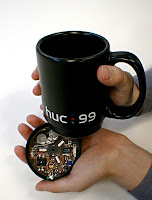After having frost and snow yesterday morning in Germany being in Porto (Portugal) is quite a treat. The KDubiq application workshop is in parallel to the summer school and yesterday evening it was interesting to meet up with some people teaching there.
The more I learn about data mining and machine learning the more I see even greater potential in many ubicomp application domains. In my talk “Ubicomp Applications and Beyond – Research Challenges and Visions” I looked back at selected applications and systems that we have developed over the last 10 year (have a look at the slides – I, too was surprised what variety of projects we did in the last years ;-). So far we have often used basic machine learning methods to implement – in many cases creating a version 2 of these systems where machine learning research is brought together with ubicomp research and new technology platforms could make a real difference.
Alessandro Donati from ESA gave a talk “Technology for challenging future space missions” which introduced several challenges. He explained their approach to technology introduction into mission control. The basic idea is that the technology providers create together with the users a new application or tool. He strongly argued for a user centred design and development process. It is interesting to see that the concept of user centred development processes are becoming more widespread and go beyond classical user interfaces into complex system development.



